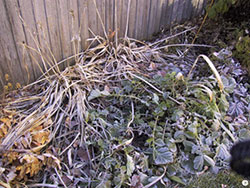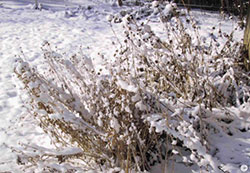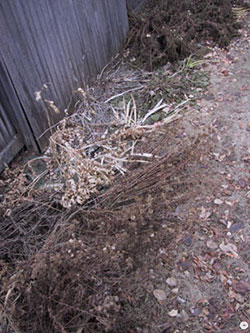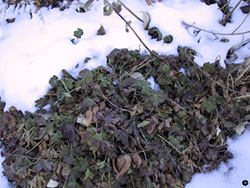Colorado’s relatively warm days and cold nights, extreme temperature fluctuations and drying winds can wreak havoc with many of our commonly planted perennials. After the first hard frost, the foliage of most perennials starts to die and wither.
What do I do with a withering perennial plant?
 One approach is to immediately remove the dead foliage. Many perennials will suffer no harm as a result, as long as you exercise great care when applying mulch. The other approach is waiting until spring to remove dead foliage. Always remove diseased foliage to discourage the spread of leaf-spot diseases and fungal problems.
One approach is to immediately remove the dead foliage. Many perennials will suffer no harm as a result, as long as you exercise great care when applying mulch. The other approach is waiting until spring to remove dead foliage. Always remove diseased foliage to discourage the spread of leaf-spot diseases and fungal problems.
How do I combat winter dehydration?
Dehydration is a common problem when snowless winters occur. A layer of mulch several inches thick helps retain soil moisture, and should be coarse and loose to permit air movement to roots. Root tissues continue to metabolize in the winter and requires oxygen for this process to take place. Reduced soil oxygen level increases the aggressiveness of many soil pathogens. Mulches which pack down should be avoided.

Should I water outside perennials in the winter?
Watering at least monthly under dry winter conditions recharges the soil profile with moisture critical to plant survival.
What is the best protection for outside perennials?
Whether you decide to remove dead foliage in the fall or wait until spring, mulches provide the best protection for your perennials. Many types of mulches are available, and no matter which you choose, there are a few guidelines you should follow.
How do I choose mulch?
 Mulches do a better job of insulating plants when space is allowed for air to circulate. Mulch that packs down to a dense mass during winter can cause mildews and molds to form. Shredded leaves from deciduous trees and pine boughs from discarded Christmas trees offer great winter protection. A good organic compost used as mulch is also effective and can be used as a soil amendment in the spring.
Mulches do a better job of insulating plants when space is allowed for air to circulate. Mulch that packs down to a dense mass during winter can cause mildews and molds to form. Shredded leaves from deciduous trees and pine boughs from discarded Christmas trees offer great winter protection. A good organic compost used as mulch is also effective and can be used as a soil amendment in the spring.
When should I lay mulch?

Established perennials and bulbs benefit from mulches that are applied after the ground freezes, because mulches don’t allow soil temperatures to fluctuate as much throughout the winter.
When should I remove mulch?
Mulch should not be removed too early in spring or plants will begin to grow too early. Plants located on the south side of a building or wall will emerge sooner than those in other areas, but may be subject to spring frost damage. Some perennials can be damaged by drying winter winds and western sun. Fencing can be used to effectively to protect plantings.
For more information, see the following Colorado State University Extension fact sheet(s).
- Perennial Gardening
- Mulches for Home Grounds
- Fall and Winter Watering
- Xeriscaping: Creating Landscaping
For more information, see the following Planttalk
Colorado™ script(s).



